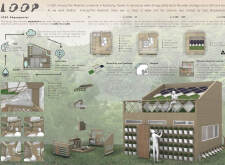5 key facts about this project
Unique Integration of Aquaponics and Sustainability
The LOOP project stands out through its specialized incorporation of aquaponic systems for food production. By creating a closed-loop ecosystem where fish and plants coexist harmoniously, the design effectively optimizes water usage while cultivating local crops. This approach not only produces food but also educates users about sustainable agriculture practices. The architectural design emphasizes simplicity and modularity, allowing adaptability to changing environmental conditions or community needs.
The project utilizes locally sourced materials such as wood, glass, and metal, ensuring durability while maintaining an ecological focus. This material choice supports the building’s structural integrity and complements its visual identity. The inclusion of water collection systems highlights the design’s commitment to self-sufficiency and minimizes reliance on external water supplies. The structure's unique green roof serves multiple purposes, offering leisure spaces, accommodating solar panels, and integrating a natural habitat for local flora.
Functional Spaces and Community Engagement
The design of LOOP prioritizes multifunctional spaces that engage the community while fulfilling essential needs. The rainwater collection system is strategically integrated into the building's structure, allowing for the effective storage and use of harvested water. Additionally, the project features dedicated areas for education and community events, promoting engagement in environmental stewardship.
The layout encourages interaction with the natural environment, making it conducive for community members to participate in activities related to food production and water conservation. The architectural design promotes a sense of ownership and responsibility among residents, directly addressing local challenges related to water management.
For deeper insights into this architectural project, including architectural plans and sections, readers are encouraged to explore the detailed presentation of LOOP. The focus on architectural ideas within the design underscores its relevance to contemporary discussions on sustainability and community-centered architecture.























